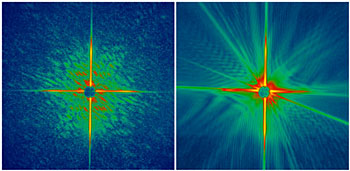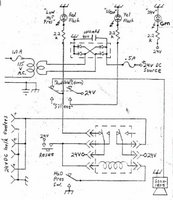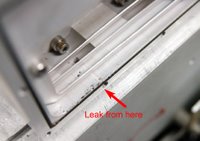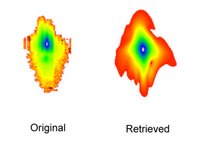Thursday, November 30, 2006
Timing delay jitter problem
Unfortunately, we could not resynchronize the TWINAMP using the two separated trigger pulses. I think the large RMS jitter from BNC 7010 digital delay generator makes the synchronization failure. So I replaced the BNC generator with SRS DG-535, the TWINAMP ran steadily. DG-535 has only 50 picosecond RMS jitter. The best way to eliminate this jitter is to control 4 channels of DG-535 by computer. If we buy a GPIB-RS232 converter from NI, it's easy to communicate with only one DG-535 for switching on or off the trigger signals("out 1" and "sync out").
Wednesday, November 29, 2006
Lasers Break an Optical Barrier -- Stimulated Emission Depletion (STED)
 This year's 10th annual German Innovation Award has been awarded to Stefan W. Hell, the director of the Max Planck Institute for Biophysical Chemistry, for his project "Light Microscopy with Unprecedented Resolution".
This year's 10th annual German Innovation Award has been awarded to Stefan W. Hell, the director of the Max Planck Institute for Biophysical Chemistry, for his project "Light Microscopy with Unprecedented Resolution".More than 100 years ago, Ernst Abbe laid down the law that the wave nature of light limits the smallest resolvable spot size to one-third of a wavelength in diameter, or approximately 200 nm. He predicted that any features smaller than this must always be blurred by diffraction and hence be indistinguishable by focusing light microscopes. Professor Hell resolved a spot that was 30 percent smaller than Abbe's minimum using a focusing fluorescence microscope and a pair of laser beams operating at different wavelengths. One beam -- a frequency-doubled UV-pulse -- caused excited molecules to be distributed by the fluorophore, while the other, slightly red-shifted fundamental beam quenched them through stimulated emission.
The researchers generated the two pulses with a Mira 900 Ti:sapphire laser, pumped by an Innova 400 argon-ion laser, both from Coherent Inc. of Santa Clara, Calif. The Ti:sapphire operated at a wavelength of 766 nm and a 120-fs pulse length. The outgoing beam was divided into an excitation beam and a fundamental. While the pulses of the first beam were frequency-doubled with a nonlinear optical crystal made by Fuzhou, China-based Casix Inc., the pulses of the fundamental were stretched to 40 ps by a Coherent grating compressor/decompressor. The technique requires pulsed lasers because, to eliminate fluorescence efficiently, the fundamental pulse must do its job in a much shorter time -- a few picoseconds --than the fluorescence lifetime of the dye -- a few nanoseconds.
related link: STED microscopy
(from Photonics.com)
Monday, November 27, 2006
New timing setup for beam stabilization system
 The beam stabilization system needs control signals from SDG II "out 1" and "sync out", so I have to change the timing again. I already modified the timing for the front end before (on July 7th), but I did not consider to trigger the Pockcel and TWIN AMP separately. Now I have to insert one more delay box such as BNC delay generator in order to trigger the TWIN AMP.
The beam stabilization system needs control signals from SDG II "out 1" and "sync out", so I have to change the timing again. I already modified the timing for the front end before (on July 7th), but I did not consider to trigger the Pockcel and TWIN AMP separately. Now I have to insert one more delay box such as BNC delay generator in order to trigger the TWIN AMP.The beam stabilization system includes one CCD camera and one chopper, both of them also need the TTL pulses to trigger. The pulses from BNC #1 to trigger CCD, #2 to trigger the beam chopper.
Wednesday, November 15, 2006
JLab FEL Breaks Power Record
The most powerful tunable laser in the world has shattered another power record. Officials report that the free-electron laser (FEL) at the Thomas Jefferson National Accelerator Facility produced a 14.2 kilowatt beam of laser light at an infrared wavelength of 1.61 um on Oct. 30.
Tuesday, November 14, 2006
Heater and reservior voltage for TWINAMP
The TWINAMP could not be triggered by internal pulse correctly but only by external signal normally yesterday. By my early experience, the problem was caused by the thyratron heater and reservoir voltages. We measured the heater voltage(V_H) from the power supply output, which is about 10.2 VAC. When I decreased this voltage down to 9.4V (the minimum adjustment), the TWINAMP ran well. We also measured the voltages from thyratron side.
On May 1st, I set the Heater and Reservoir voltages: V_H=11.35V, V_R=8.35V. On Oct. 18, 2005, we set the voltages: V_H=7.05V, V_R=7.49V.
| Power Supply Output | Before filter | Before Thyratron | |
| V_Heater(VAC) | 9.30 | 7.80 | 7.50 |
| V_Resevior(VAC) | 7.78 | 7.48 | 7.48 |
On May 1st, I set the Heater and Reservoir voltages: V_H=11.35V, V_R=8.35V. On Oct. 18, 2005, we set the voltages: V_H=7.05V, V_R=7.49V.
Ultrafast, Intense Laser Captures Nanoscale Images
HAMBURG, Germany, Nov. 14, 2006 -- Using a single, extremely short and intense x-ray laser pulse, an international team of scientists have, for the first time, taken a high-resolution diffraction image of an object such as a protein before the intensity of the radiation destroyed the sample. The experiment was the first successful application of "flash diffractive imaging" and begins a new era in structural research.

The new method will be applicable to atomic-resolution imaging of complex biomolecules when even more powerful x-ray lasers, currently under construction, are available. The technique will allow scientists to gain insight into the fields of materials science, plasma physics, biology and medicine.
The scientists, part of an international collaboration led by Lawrence Livermore National Laboratory's (LLNL) Henry Chapman and Janos Hajdu of Uppsala University in Sweden, achieved the feat using the world's first soft x-ray free-electron laser, located at the FLASH facility at Deutsches Elektronen-Synchrotron (DESY) in Hamburg. Their work will appear on the cover of the December issue of the journal Nature Physics (12 November 2006 | doi:10.1038/nphys461).
The experiment suggests that in the near future, images from nanoparticles and even large individual macromolecules -- viruses or cells -- may be obtained using a single, ultrashort high-intensity laser pulse before the sample explodes and turns into a plasma. This means that scientists could better understand the structure of macromolecular proteins without crystallizing them, which is required in conventional x-ray structure analysis, and have the ability to rapidly study all classes of proteins.
(From Photonics.com)

The new method will be applicable to atomic-resolution imaging of complex biomolecules when even more powerful x-ray lasers, currently under construction, are available. The technique will allow scientists to gain insight into the fields of materials science, plasma physics, biology and medicine.
The scientists, part of an international collaboration led by Lawrence Livermore National Laboratory's (LLNL) Henry Chapman and Janos Hajdu of Uppsala University in Sweden, achieved the feat using the world's first soft x-ray free-electron laser, located at the FLASH facility at Deutsches Elektronen-Synchrotron (DESY) in Hamburg. Their work will appear on the cover of the December issue of the journal Nature Physics (12 November 2006 | doi:10.1038/nphys461).
The experiment suggests that in the near future, images from nanoparticles and even large individual macromolecules -- viruses or cells -- may be obtained using a single, ultrashort high-intensity laser pulse before the sample explodes and turns into a plasma. This means that scientists could better understand the structure of macromolecular proteins without crystallizing them, which is required in conventional x-ray structure analysis, and have the ability to rapidly study all classes of proteins.
(From Photonics.com)
Friday, November 10, 2006
Low water pressure alert system
 The water pressure alert system has been used in our lab for many years. When the city water pressure is low, the system will buzz loudly, then the 24V control signal will be shut down. This alert system looks simple but very useful. It is used to protect the diffusion pump water cooling for x-ray and YAG laser water cooling system.
The water pressure alert system has been used in our lab for many years. When the city water pressure is low, the system will buzz loudly, then the 24V control signal will be shut down. This alert system looks simple but very useful. It is used to protect the diffusion pump water cooling for x-ray and YAG laser water cooling system.From last week, the alarm kept buzzing. I had to set the alarm to silent. I opened the circuit box to check today and found the problem came from the reset button. When I pushed the button, the reset could not be short. So even the water pressure sensor operated well, the 24V power could not be applied to the relay coil. The alarm was recovered after the reset button was replaced.
Thursday, November 09, 2006
Replaced Hurricane compressor grating
Due to the air humidity, the compressor grating absorbed some dust, this finally decrease the reflection efficiency. We replaced the old grating with the brand new one ordered from Spectra-physics. The measured power before compressor is about 500mW, after the compressor, the power is 300mW, which is bigger than 260mW using the old grating.
The power was decreased to 250mW when I added the 1.02ms delay for diode pump laser. After the delay time adjusted accurately, the power recovered to 300mW. The new delay time is 1020.2us.
The power was decreased to 250mW when I added the 1.02ms delay for diode pump laser. After the delay time adjusted accurately, the power recovered to 300mW. The new delay time is 1020.2us.
Wednesday, November 08, 2006
Leak from Alumnium box
 We cleaned all TWINAMP windows, filled 400mbar F2 + 1400mbar He for leakage detection last night. We found the pressure was dropped by 50mbar for the long tube, and we could smell pungently. Because the o-rings for window and PVDF plate were changed last month, maybe the gas leak came from the aluminum box connected to the window frame. We found some black grain in the aluminum box. The o-ings were changed immediately.
We cleaned all TWINAMP windows, filled 400mbar F2 + 1400mbar He for leakage detection last night. We found the pressure was dropped by 50mbar for the long tube, and we could smell pungently. Because the o-rings for window and PVDF plate were changed last month, maybe the gas leak came from the aluminum box connected to the window frame. We found some black grain in the aluminum box. The o-ings were changed immediately.
Tuesday, November 07, 2006
O-ring sizes for TWINAMP
#1. between PVDF frame and Al box
#2. between Al box and 2nd plate
#3. between 2nd plate and PVDF plate
#4. between PVDF plate and window
For Short tube: window size 75 x 40 x 5.1
#1. 60 x 2
#2. 120 x 2
#3,4. 64 x 2 (if the opening on the end plate and PVDF is 65)
60 (or 62) x 2 (if the opening on the end plate and PVDF is 60)
O-ring between reservoir and PVDF fram: 410 x 4
O-ring between PVDF reservoir and upper ground plate: 400 x 4
For Long tube: window 100 x 50 x 10
#1. 85 x 2
#2. 125 x 2
#3,4. 85 x 2
#2. between Al box and 2nd plate
#3. between 2nd plate and PVDF plate
#4. between PVDF plate and window
For Short tube: window size 75 x 40 x 5.1
#1. 60 x 2
#2. 120 x 2
#3,4. 64 x 2 (if the opening on the end plate and PVDF is 65)
60 (or 62) x 2 (if the opening on the end plate and PVDF is 60)
O-ring between reservoir and PVDF fram: 410 x 4
O-ring between PVDF reservoir and upper ground plate: 400 x 4
For Long tube: window 100 x 50 x 10
#1. 85 x 2
#2. 125 x 2
#3,4. 85 x 2
Monday, November 06, 2006
Repolished the TWINAMP long tube windows
We removed t he winodws from TWINAMP lone tube, and found they were very dirty. The small black grains on the surface like last time. There was a thin gray film on the inside surface when we looked the windows at the grazing angle. This film could not be removed by normal optical cleaning method. So we tried to repolish it using 1 micro power. After repolishing, the surface looked very smooth.
Thursday, November 02, 2006
Pulse measurement for final amplifier
 The Prometheus gases has been changed.
The Prometheus gases has been changed.We calibrated the energy meter for large target chamber, it's about 30 times between the outside meter and the real energy. The output energy from the front end is about 16 mJ, the high voltage of Prometheus is 22 kV. The measured energy before the target nozzle is ~ 220 mJ.
The time duration and the phase were measured by FROG. The raw data and the retrieved data looks similar. Compared the front end measurement, the pulse was enlarged because of the dispersion. The pulse width is around 190-220 femtoseconds, the phase kept flat.

Wednesday, November 01, 2006
Subscribe to:
Posts (Atom)
